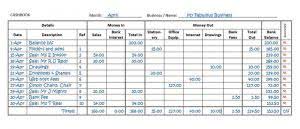
The primary purpose of an income statement is to convey details of profitability and business activities of the company to the stakeholders. By understanding the income and expense components of the statement, an investor can appreciate what makes a company profitable. Following operating expenses are other forms of income, known as income from continuing operations. This includes operating income, other net income, interest-linked expenses, and applicable taxes. Added these together with operating income arrives at a net income of $88.1 billion for Microsoft. This statement is a great place to begin a financial model, as it requires the least amount of information from the balance sheet and cash flow statement.
- (The depreciation journal entry includes a debit to Depreciation Expense and a credit to Accumulated Depreciation, a contra asset account).
- Operating expenses are the costs incurred through regular business activities unrelated to production.
- Another key item on the income statement is operating expenses, which include things like selling, general, and administrative expenses.
- Knowing your operating expenses allows you to calculate your company’s operating expense ratio (OER), which helps you compare your expenses to income.
- It is called the single-step income statement as it is based on a simple calculation that sums up revenue and gains and subtracts expenses and losses.
- The interest coverage ratio is also known as the Times interest earned is a financial measure that shows how well a company can pay its interest expenses.
Firm of the Future
The cash method records revenues when cash is received and expenses when cash is paid out. Most companies use the accrual income statement method because it provides a more accurate portrayal of a company’s financial activity. It is called a “multi-step” income statement because it breaks down the operating activities into different steps.

Income Statement Items Explained (With Examples)
The last step in the accounting cycle (not counting reversing entries) is to prepare a post-closing trial balance. They are prepared at different stages in the accounting cycle but have the same purpose – i.e. to test the equality between debits and credits. This chapter presents the different accounts you may encounter in an income statement, examples for each type of business, and the formats used in preparing this report. Creditors and banks use the Profit and Loss Account to evaluate a company’s ability to repay its debts.
For Public Companies

Non-operating revenue is accounts found on income statement the money realized from the secondary activities of a business. When the variable cost is deducted from the sales revenue, we have the contribution margin. The contribution margin, therefore, is the money that is left after deducting the variable costs from the sales revenue.
This ultimately increased profit by $9,000,000 because reported expenses were too low. The items that would be included in this line involve the income or loss involving foreign currency transactions, hedges, and pension liabilities. The accounting method under which revenues are recognized on the income statement when they are earned (rather than when the cash is received). Net sales is the first amount shown on the income statement of a retailer, manufacturer, or other companies which sell products. In other words, sales are generally the main operating revenues for companies selling goods.

The statement displays the company’s revenue, costs, gross profit, selling and administrative expenses, other expenses and income, taxes paid, and net profit in a coherent and logical manner. The income statement measures a company’s financial performance over time, while the balance sheet provides a snapshot of a company’s financial position at a particular point in time. Both the income statement and balance sheet are important tools for business owners and investors alike. By understanding how these two financial statements work, you can get a better grasp of a company’s overall financial health. Some of the accounts that can be found in the income statement include revenue, expenses such as compensation and marketing, cost of goods sold, and taxes.
The income statement formula outlines 3 key values that can be derived from the statement of operations. These three values determined by the income statement formula include gross profit, operating income, and net income. The EBITDA on an income statement is calculated by finding the difference between the gross profit and the selling, general and administrative expenses (SGA).
Manufacturing Versus Merchandising Income Statements

Note that net income isn’t necessarily the same as cash flow, or the money that a firm has available to pay its immediate bills, because accrual accounting often includes non-cash items like depreciation. The income statement provides financial information to the users, such as shareholders, investors, lenders, and suppliers, on how the company is doing during the accounting period. In this case, the users can use the income statement, together with other financial statements, such as balance sheet and statement of cash flows, to make a business decision involving the company. Creditors are often more concerned about a company’s future cash flows than its past profitability. However, their research analysts can use an income statement to compare year-on-year and quarter-on-quarter performance. An earnings statement focuses on a company’s profitability, recording all revenues and expenses over a set period of time.
- Further, the option of switching from one accounting policy to another provides an opportunity for manipulators.
- Get free guides, articles, tools and calculators to help you navigate the financial side of your business with ease.
- You get to know the actual changes in the dollar value of each item, whether it increases or decreases over time.
- Assets turnover is a key financial metric that measures how efficiently a company is using its assets to generate revenue.
- One of perhaps 1,000 rules in US GAAP is a requirement that the income statement be prepared using the accrual method of accounting.
- The earnings per share is calculated by dividing the net income by the number of shares outstanding.
What are Income Accounts in accounting?
Single-step income statements include revenue, gains, expenses, and losses, and they strictly show operating costs. The Profit and Loss Account is prepared by an accountant, and it Accounting For Architects is an essential tool for measuring the financial performance of a business. The statement shows the company’s revenue, cost of goods sold, gross profit, operating expenses, and net profit or loss. Your final step in analysing an income statement is to arrive at the net income. This is obtained by subtracting total expenses (including taxes) from total revenues.


